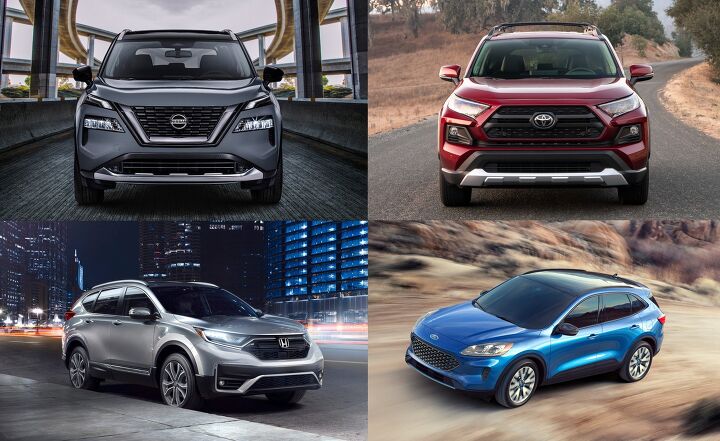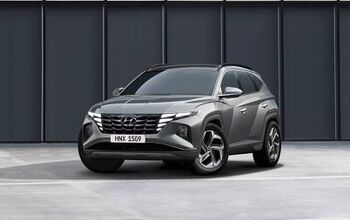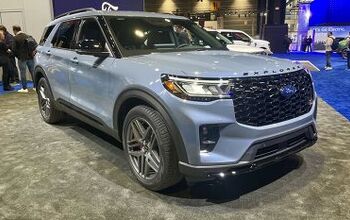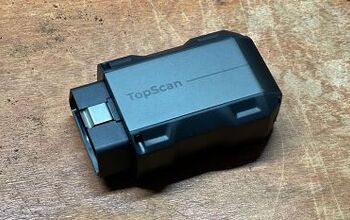Nissan Rogue Vs Honda CR-V Vs Toyota RAV4 Vs Ford Escape: How Does It Stack Up?

A solitary powertrain, upscale cabin, and class-leading convenience features—but is it enough?
The 2021 Nissan Rogue has its work cut out. It sits in a segment that is possibly not only the most hotly contested crossover segment but the most competitive segment period. Its chief rivals are the Honda CR-V, Toyota RAV4, and Ford Escape. Each of the new Rogue’s rival has its own niche and offers a wide range of powertrains and features. Does the 2021 Rogue have enough on offer, even if on paper, to challenge its rivals and carve its own niche?
Get a Quote on a New Nissan Rogue, Honda CR-V, Toyota RAV4 or Ford EscapeBy The Measurements
dimension | Nissan Rogue | Honda CR-V | Toyota RAV4 | Ford Escape |
|---|---|---|---|---|
length | 183.0 in | 182.1 in | 180.9 in | 180.5 in |
width | 72.4 in | 71.9 in | 73.0 in | 74.1 in |
height | 66.9 in | 66.1 in | 67.0 in | 68.6 in |
wheelbase | 106.5 in | 104.8 in | 105.9 in | 106.7 in |
curb weight | N/A | 3337 / 3455 / 3649 (hybrid) lb | 3370 / 3710 (hybrid) lb | 3,298 / 3,414 / 3,554 (hybrid) lb |
headroom (f/r) | 41.1 / 39.2 in | 40.1 / 39.1 in | 37.7 / 39.5 in | 40.0 / 39.3 in |
legroom (f/r) | 43.3 / 36.8 in | 41.3 / 40.3 in | 41.0 / 37.8 in | 42.4 / 40.7 in |
shoulder room (f/r) | 57.1 / 55.9 in | 57.9 / 55.6 in | 57.8 / 56.4 in | 57.6 / 56.0 in |
trunk space | 39.3 cu-ft | 39.2 / 33.2 (hybrid) cu-ft | 37.6 cu-ft | 37.5 cu-ft |
Let’s just cut to the chase. Technically speaking, the 2021 Nissan Rogue will be the newest and longest among its competition. Add to that a wheelbase that stretches 106.5 inches—second only to the Escape (106.7 inches)—it wouldn’t be far-fetched to think that the cabin will be spacious. And it is … well, in part at least. With maximum headroom of 41.1 inches, it offers the most headroom among its competition. With the moonroof however, the front headroom drops to 39.2 inches which is 0.3 inches lower compared to the RAV4 and 0.1 inches lower compared to the Ford. It still beats the Honda by a tenth, however.
Despite its length and wheelbase, the Rogue falls way short of its competition in terms of legroom. It offers only 36.8 inches of the stuff at the rear bench compared to 40.7 inches in the Escape. The Escape is the most spacious for rear occupants in this comparison. Where, you might wonder, has all the space gone then? You might think the Rogue compromises on the rear space in favor of cargo volume.
But the CR-V offers 39.2 cu-ft of cargo space which is just 0.1 cu-ft less than the Rogue despite offering almost four extra inches of legroom at the rear bench. Same is the case with the RAV4 which offers only 37.6 cu-ft of cargo volume despite the 37.8-inch rear legroom. So in essence, even the tallest passengers will be comfortable in the front seats but the rear legroom would be adequate for average adults only.
SEE ALSO: First Drive: 2020 Honda CR-V Hybrid ReviewEngine and Drivetrain
performance | Nissan Rogue | Honda CR-V | Toyota RAV4 | Ford Escape |
|---|---|---|---|---|
engine | 2.5-liter I4 | 1.5-liter I4 turbo / 2.0-liter I4 hybrid | 2.5-liter I4 / 2.5-liter atkinson cycle I4 hybrid | 1.5-liter I3 turbo / 2.0-liter I4 turbo / 2.5-liter hybrid |
horsepower | 181 hp | 190 / 212 (hybrid) hp | 203 / 219 (hybrid) hp | 180/250/198 hp |
torque | 181 lb-ft | 179 / 232 lb-ft | 184 /NA lb-ft | 177/275/NA lb-ft |
transmission | CVT | CVT / ECVT | eight-speed automatic/ ECVT | eight-speed automatic/ ECVT |
mpg | N/A | 28/34/30 (FWD), 27/32/29 (AWD), 40/35/38 (hybrid) | 27/35/30 (FWD), 27/33/29 (AWD), 41/38/40 (hybrid) | 27/33/30 (1.5), 23/31/26 (2.0), 44/37.41 (hybrid) |
0–60 mph | N/A | N/A | N/A | 6.0 sec |
This is where the Nissan will fall short when compared to its competition. Unlike every other car on the list, the Nissan Rogue will be available with a solitary engine option, the 2.5-liter four-cylinder making 181 hp and 181 lb-ft of torque. Plus, the engine will be available with a CVT gearbox only. Though, the powertrain will be available with both FWD and AWD. The Honda CR-V, Toyota RAV4, and Ford Escape all offer gasoline and hybrid powertrains. The Toyota and Ford even come as plug-in hybrids as well, though we’ve left those out of this comparison.
Honda offers the CR-V with two engines, a 1.5-liter four-cylinder turbo, and a 2.0-liter hybrid. The 1.5-liter turbo makes 190 hp and 179 lb-ft of torque while the hybrid puts out 212 hp of combined power and 232 lb-ft of torque. The gasoline engine is available with a CVT gearbox while the hybrid comes with the E-CVT. Both powertrains are available with AWD; you can have the hybrid in any CR-V trim you like including the base LX. In addition, AWD is also available as an option on the gasoline engines but comes as standard on all hybrid trims.
The Toyota RAV4 is by far the most popular crossover of the four and it’s easy to see why. It brings to the table Toyota’s bulletproof reliability along with three robust powertrains which includes a plug-in hybrid as well. The RAV4 is available with a 2.5-liter gasoline engine, a hybrid and a plug-in hybrid that utilize the same engine. In its gasoline form, the 2.5-liter four-cylinder makes 203 hp and 184 lb-ft of torque and comes with an eight-speed automatic gearbox.
SEE ALSO: 2020 Toyota RAV4 TRD Off-Road ReviewAs a hybrid the power jumps to 219 hp. The soon-to-launch RAV4 Prime plug-in bumps that to 302 hp, which will make it the fastest four-door Toyota, with a 0-60 mph time of 5.7 seconds. Both hybrids come with the E-CVT gearbox. While AWD is available as an option on all gasoline trims, all hybrids come with on-demand AWD as standard. The RAV4 is also the most fuel-efficient of the four on the list.
Technology and Features
Pricing
The prices for the 2021 Nissan Rogue are not yet available. But if we had to guess, we think it will be priced competitively and will likely undercut its competition by a fair margin. To be fair, it will need to do that as convenience features and an upscale interior are its only trump cards and a price in-line with the others will be detrimental to the car’s sales.
As for what it’s up against, Toyota’s RAV4 starts at $27,070 for the gasoline models and tops out at $36,400. The hybrids start at $29,470 with the top trim coming in at $38,800. Starting price for the Escape on the other hand is about $1,000 less compared to the RAV4. It starts at $26,130 and tops out at $37,825. The hybrid trims start from $29,655. As for the CR-V, the gasoline models start from $26,170 for the base LX trim and go up to $34,370 for the top Touring trim. The hybrid starts at $28,870 and tops out at $37,070.
Become an AutoGuide insider. Get the latest from the automotive world first by subscribing to our newsletter here.

More by Kshitij Sharma









































Comments
Join the conversation